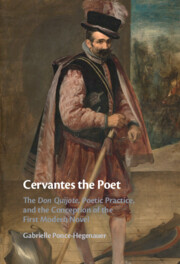 Cervantes the Poet
Cervantes the Poet Published online by Cambridge University Press: 11 May 2023
Chapter 3 explores how an exemplary amorous biography, a type of vita poetica or literary hagiography, was attributed to el divino Francesco Petrarch over the course of the sixteenth century. Imitatio applied not only to the figures and tropes of the Trionfi and Canzoniere, but also to the figura of the poet as a model or exemplar for the life of an author. After roughly two centuries (1374–1575), Petrarch’s lasting fame became literary immortality like that of ancient authors (Homer and Vergil). From the 1535 alleged rediscovery of Laura’s grave and Alessandro Piccolomini’s 1540 pilgrimage to Petrarch’s tomb, to the various sixteenth-century translations of Petrarch’s poetry, and commentaries made by lyric poets in the front matter to publications, in manuscript poems, and in pastoral fiction, the literary afterlife of the figura of the poet took shape. This chapter reconstructs the figura of the poet as it was imagined, articulated, imitated, and reinvented by sixteenth-century poets writing in Castilian. By the middle of the sixteenth century the Castilianized ingenio (ingenium) had come to define the figura of the poet. This chapter fills in a lacuna (Garcilaso to Góngora) of roughly sixty years which is crucial to Cervantes’ work and studies of early modern poetics.
To save this book to your Kindle, first ensure [email protected] is added to your Approved Personal Document E-mail List under your Personal Document Settings on the Manage Your Content and Devices page of your Amazon account. Then enter the ‘name’ part of your Kindle email address below. Find out more about saving to your Kindle.
Note you can select to save to either the @free.kindle.com or @kindle.com variations. ‘@free.kindle.com’ emails are free but can only be saved to your device when it is connected to wi-fi. ‘@kindle.com’ emails can be delivered even when you are not connected to wi-fi, but note that service fees apply.
Find out more about the Kindle Personal Document Service.
To save content items to your account, please confirm that you agree to abide by our usage policies. If this is the first time you use this feature, you will be asked to authorise Cambridge Core to connect with your account. Find out more about saving content to Dropbox.
To save content items to your account, please confirm that you agree to abide by our usage policies. If this is the first time you use this feature, you will be asked to authorise Cambridge Core to connect with your account. Find out more about saving content to Google Drive.